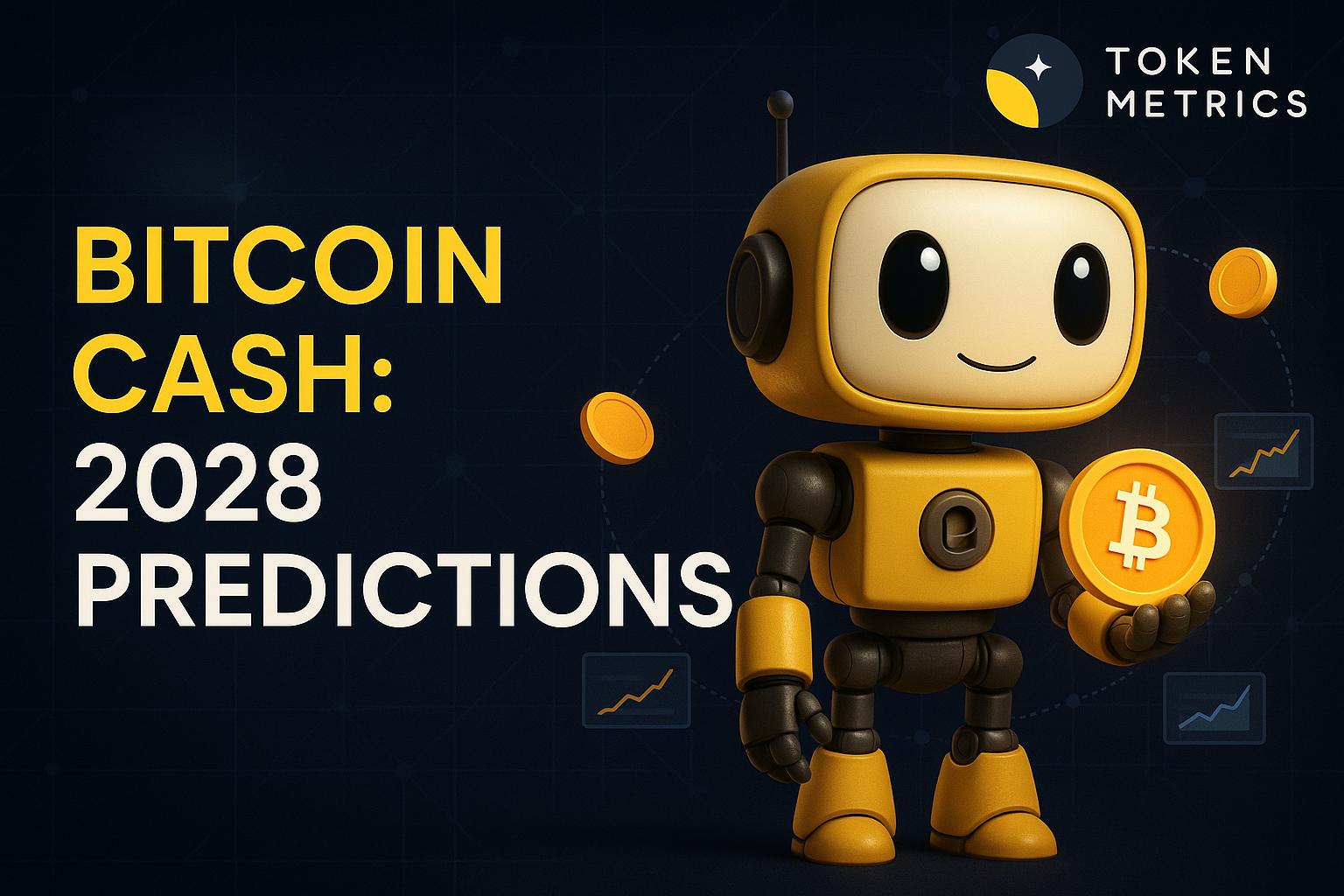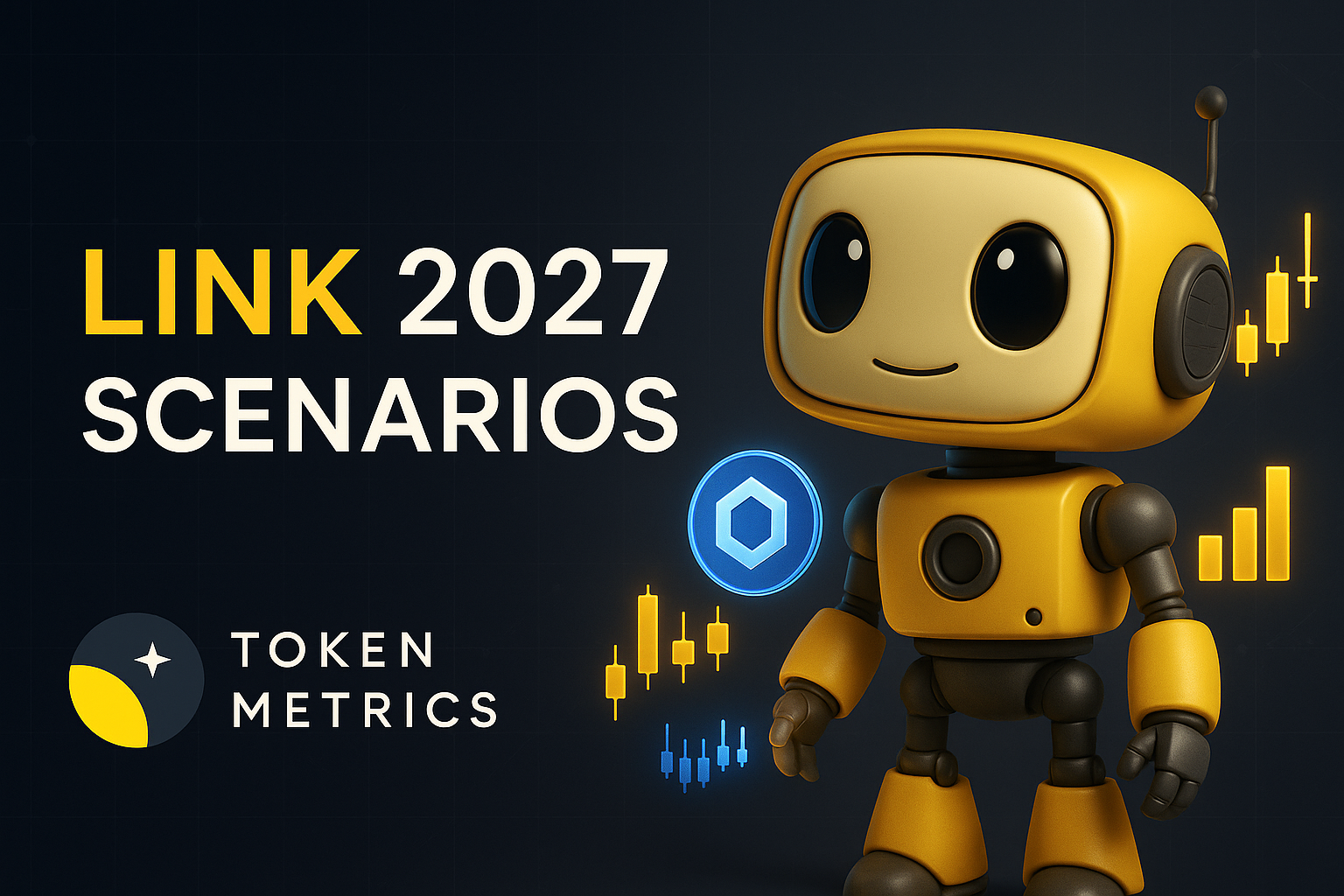Top Crypto Trading Platforms in 2025







%201.svg)
%201.svg)
Big news: We’re cranking up the heat on AI-driven crypto analytics with the launch of the Token Metrics API and our official SDK (Software Development Kit). This isn’t just an upgrade – it's a quantum leap, giving traders, hedge funds, developers, and institutions direct access to cutting-edge market intelligence, trading signals, and predictive analytics.
Crypto markets move fast, and having real-time, AI-powered insights can be the difference between catching the next big trend or getting left behind. Until now, traders and quants have been wrestling with scattered data, delayed reporting, and a lack of truly predictive analytics. Not anymore.
The Token Metrics API delivers 32+ high-performance endpoints packed with powerful AI-driven insights right into your lap, including:
Getting started with the Token Metrics API is simple:
At Token Metrics, we believe data should be decentralized, predictive, and actionable.
The Token Metrics API & SDK bring next-gen AI-powered crypto intelligence to anyone looking to trade smarter, build better, and stay ahead of the curve. With our official SDK, developers can plug these insights into their own trading bots, dashboards, and research tools – no need to reinvent the wheel.
%201.svg)
%201.svg)
Infrastructure protocols become more valuable as the crypto ecosystem scales and relies on robust middleware. Chainlink provides critical oracle infrastructure where proven utility and deep integrations drive long-term value over retail speculation. Increasing institutional adoption raises demand for professional-grade data delivery and security.
Token Metrics projections for LINK below span multiple total market cap scenarios from conservative to aggressive. Each tier assumes different levels of infrastructure demand as crypto evolves from speculative markets to institutional-grade systems. These bands frame LINK's potential outcomes into 2027.

Disclosure
Educational purposes only, not financial advice. Crypto is volatile, do your own research and manage risk.
How to read it: Each band blends cycle analogues and market-cap share math with TA guardrails. Base assumes steady adoption and neutral or positive macro. Moon layers in a liquidity boom. Bear assumes muted flows and tighter liquidity.
TM Agent baseline: Token Metrics lead metric for Chainlink, cashtag $LINK, is a TM Grade of 23.31%, which translates to a Sell, and the trading signal is bearish, indicating short-term downward momentum. This means Token Metrics currently does not endorse $LINK as a long-term buy at current conditions.
Live details: Chainlink Token Details
Affiliate Disclosure: We may earn a commission from qualifying purchases made via this link, at no extra cost to you.
Token Metrics scenarios span four market cap tiers, each representing different levels of crypto market maturity and liquidity:
8T: At an 8 trillion dollar total crypto market cap, LINK projects to $26.10 in bear conditions, $30.65 in the base case, and $35.20 in bullish scenarios.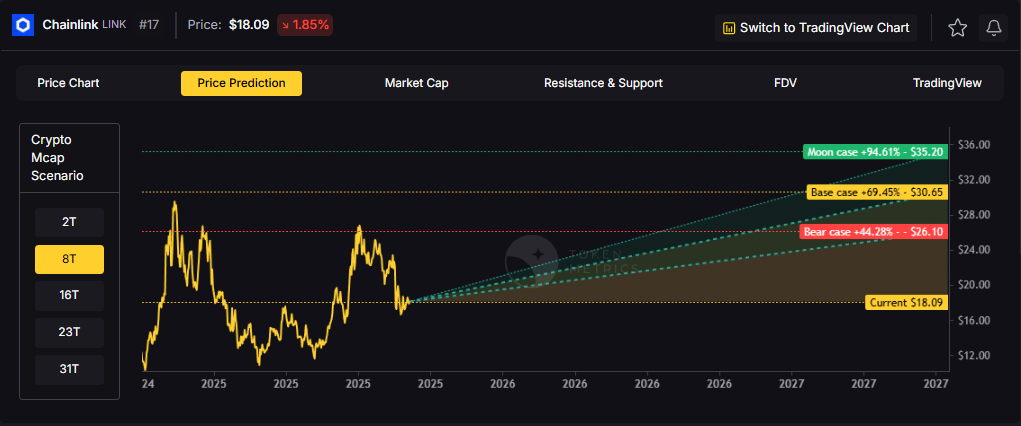
16T: Doubling the market to 16 trillion expands the range to $42.64 (bear), $56.29 (base), and $69.95 (moon).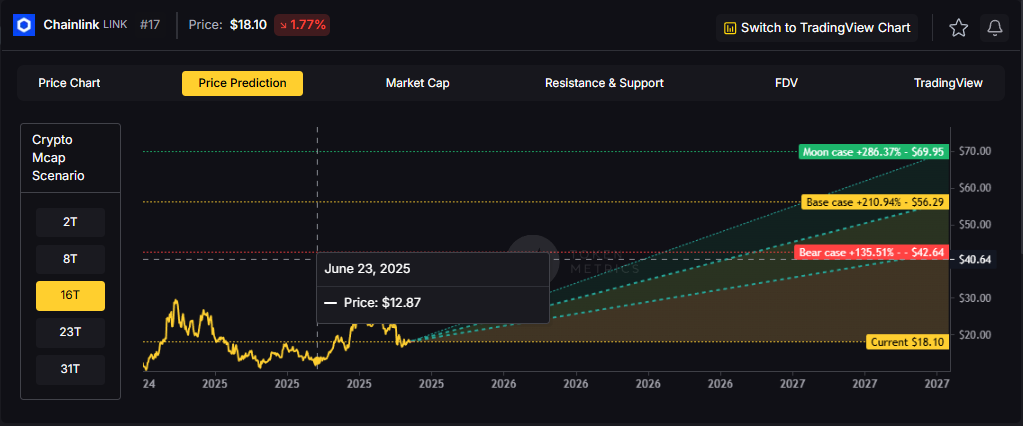
23T: At 23 trillion, the scenarios show $59.18, $81.94, and $104.70 respectively.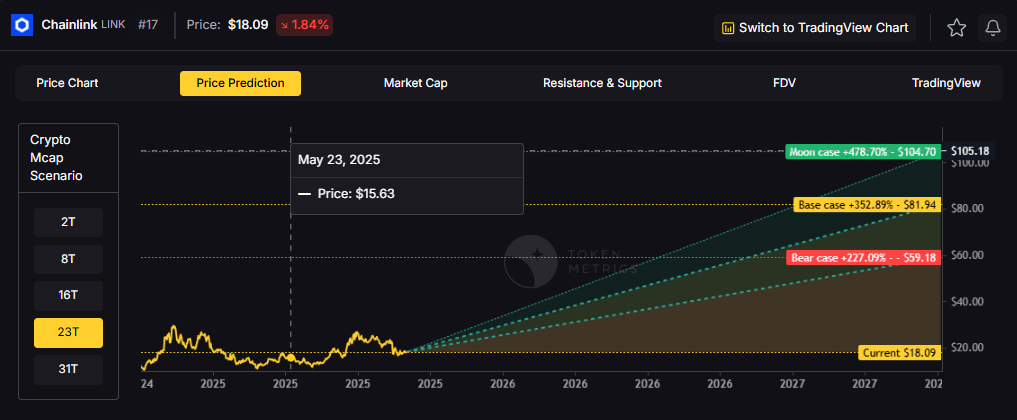
31T: In the maximum liquidity scenario of 31 trillion, LINK could reach $75.71 (bear), $107.58 (base), or $139.44 (moon).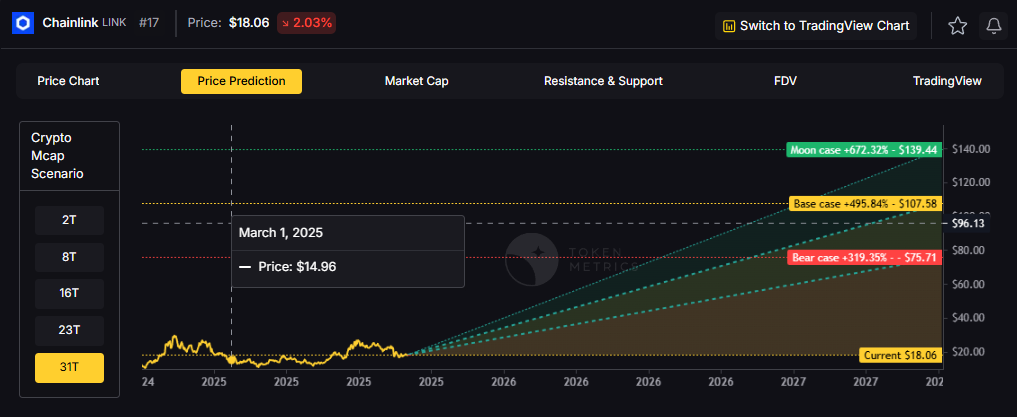
Chainlink represents one opportunity among hundreds in crypto markets. Token Metrics Indices bundle LINK with top one hundred assets for systematic exposure to the strongest projects. Single tokens face idiosyncratic risks that diversified baskets mitigate.
Historical index performance demonstrates the value of systematic diversification versus concentrated positions.
Chainlink is a decentralized oracle network that connects smart contracts to real-world data and systems. It enables secure retrieval and verification of off-chain information, supports computation, and integrates across multiple blockchains. As adoption grows, Chainlink serves as critical infrastructure for reliable data feeds and automation.
The LINK token is used to pay node operators and secure the network’s services. Common use cases include DeFi price feeds, insurance, and enterprise integrations, with CCIP extending cross-chain messaging and token transfers.
Vision: Chainlink aims to create a decentralized, secure, and reliable network for connecting smart contracts with real-world data and systems. Its vision is to become the standard for how blockchains interact with external environments, enabling trust-minimized automation across industries.
Problem: Smart contracts cannot natively access data outside their blockchain, limiting their functionality. Relying on centralized oracles introduces single points of failure and undermines the security and decentralization of blockchain applications. This creates a critical need for a trustless, tamper-proof way to bring real-world information onto blockchains.
Solution: Chainlink solves this by operating a decentralized network of node operators that fetch, aggregate, and deliver data from off-chain sources to smart contracts. It uses cryptographic proofs, reputation systems, and economic incentives to ensure data integrity. The network supports various data types and computation tasks, allowing developers to build complex, data-driven decentralized applications.
Market Analysis: Chainlink is a market leader in the oracle space and a key infrastructure component in the broader blockchain ecosystem, particularly within Ethereum and other smart contract platforms. It faces competition from emerging oracle networks like Band Protocol and API3, but maintains a strong first-mover advantage and widespread integration across DeFi, NFTs, and enterprise blockchain solutions. Adoption is driven by developer activity, partnerships with major blockchain projects, and demand for secure data feeds. Key risks include technological shifts, regulatory scrutiny on data providers, and execution challenges in scaling decentralized oracle networks. As smart contract usage grows, so does the potential for oracle services, positioning Chainlink at the center of a critical niche, though its success depends on maintaining security and decentralization over time.
Fundamental Grade: 74.58% (Community 81%, Tokenomics 100%, Exchange 100%, VC —, DeFi Scanner 17%).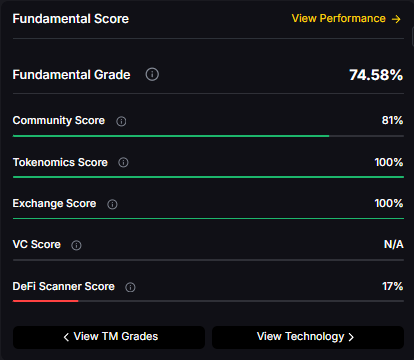
Technology Grade: 88.50% (Activity 81%, Repository 72%, Collaboration 100%, Security 86%, DeFi Scanner 17%).
Can LINK reach $100?
Yes. Based on the scenarios, LINK could reach $100+ in the 23T moon case. The 23T tier projects $104.70 in the moon case. Not financial advice.
What price could LINK reach in the moon case?
Moon case projections range from $35.20 at 8T to $139.44 at 31T. These scenarios assume maximum liquidity expansion and strong Chainlink adoption. Not financial advice.
Should I buy LINK now or wait?
Timing depends on risk tolerance and macro outlook. Current price of $18.09 sits below the 8T bear case in the scenarios. Dollar-cost averaging may reduce timing risk. Not financial advice.
Track live grades and signals: Token Details
Want exposure? Buy LINK on MEXC
Disclosure
Educational purposes only, not financial advice. Crypto is volatile, do your own research and manage risk.
Discover the full potential of your crypto research and portfolio management with Token Metrics. Our ratings combine AI-driven analytics, on-chain data, and decades of investing expertise—giving you the edge to navigate fast-changing markets. Try our platform to access scenario-based price targets, token grades, indices, and more for institutional and individual investors. Token Metrics is your research partner through every crypto market cycle.
%201.svg)
%201.svg)
The crypto market is tilting bullish into 2026 as liquidity, infrastructure, and participation improve across the board. Clearer rules and standards are reshaping the classic four-year cycle, flows can arrive earlier, and strength can persist longer than in prior expansions.
Institutional access is widening through ETFs and custody, while L2 scaling and real-world integrations help sustain on‑chain activity. This healthier backdrop frames our scenario work for HYPE. The ranges below reflect different total crypto market sizes and the share Hyperliquid could capture under each regime.
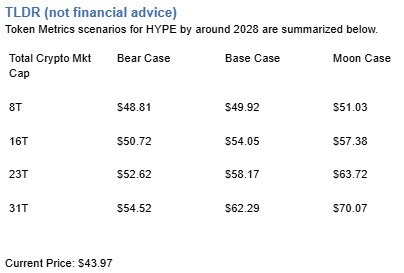
Disclosure
Educational purposes only, not financial advice. Crypto is volatile, do your own research and manage risk.
How to read it: Each band blends cycle analogues and market-cap share math with TA guardrails. Base assumes steady adoption and neutral or positive macro. Moon layers in a liquidity boom. Bear assumes muted flows and tighter liquidity.
TM Agent baseline: Token Metrics TM Grade is 73.9%, a Buy, and the trading signal is bearish, indicating short-term downward momentum. This means Token Metrics judges HYPE as fundamentally attractive over the long term, while near-term momentum is negative and may limit rallies.
Live details: Hyperliquid Token Details
Affiliate Disclosure: We may earn a commission from qualifying purchases made via this link, at no extra cost to you.
Scenario Analysis
Token Metrics scenarios span four market cap tiers, each representing different levels of crypto market maturity and liquidity:
8T: At an 8 trillion dollar total crypto market cap, HYPE projects to $48.81 in bear conditions, $49.92 in the base case, and $51.03 in bullish scenarios.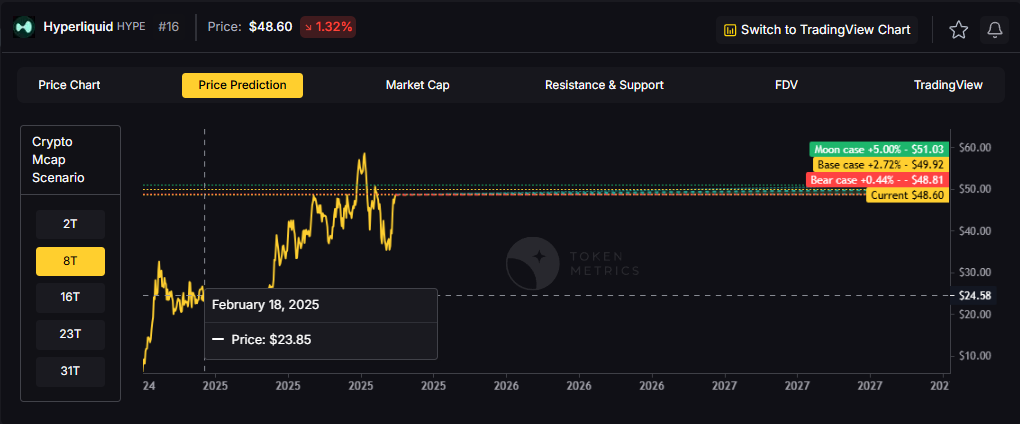
16T: Doubling the market to 16 trillion expands the range to $50.72 (bear), $54.05 (base), and $57.38 (moon).
23T: At 23 trillion, the scenarios show $52.62, $58.17, and $63.72 respectively.
31T: In the maximum liquidity scenario of 31 trillion, HYPE could reach $54.52 (bear), $62.29 (base), or $70.07 (moon).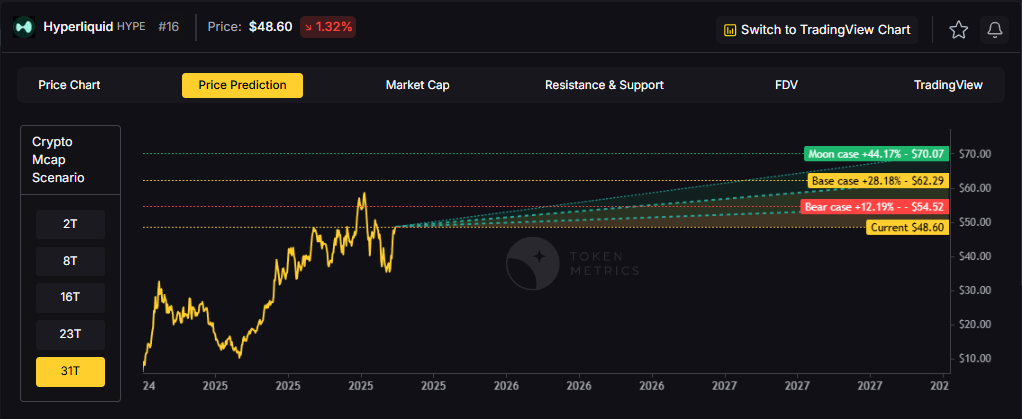
Each tier assumes progressively stronger market conditions, with the base case reflecting steady growth and the moon case requiring sustained bull market dynamics.
Diversification matters. HYPE is compelling, yet concentrated bets can be volatile. Token Metrics Indices hold HYPE alongside the top one hundred tokens for broad exposure to leaders and emerging winners.
Our backtests indicate that owning the full market with diversified indices has historically outperformed both the total market and Bitcoin in many regimes due to diversification and rotation.
Hyperliquid is a decentralized exchange focused on perpetual futures with a high-performance order book architecture. The project emphasizes low-latency trading, risk controls, and capital efficiency aimed at professional and retail derivatives traders. Its token, HYPE, is used for ecosystem incentives and governance-related utilities.
Can HYPE reach $60?
Yes, the 23T and 31T tiers imply ranges above $60 in the Base and Moon bands, though outcomes depend on liquidity and adoption. Not financial advice.
Is HYPE a good long-term investment?
Outcome depends on adoption, liquidity regime, competition, and supply dynamics. Diversify and size positions responsibly.
Disclosure
Educational purposes only, not financial advice. Crypto is volatile, do your own research and manage risk.
Token Metrics delivers AI-based crypto ratings, scenario projections, and portfolio tools so you can make smarter decisions. Discover real-time analytics on Token Metrics.
%201.svg)
%201.svg)
The Layer 1 competitive landscape is consolidating as markets recognize that specialization matters more than being a generic "Ethereum killer." Cardano positions itself in this multi-chain world with specific technical and ecosystem advantages. Infrastructure maturity around custody, bridges, and developer tools makes alternative L1s more accessible heading into 2026.
The scenario projections below map different market share outcomes for ADA across varying total crypto market sizes. Base cases assume Cardano maintains current ecosystem momentum, while moon scenarios factor in accelerated adoption and bear cases reflect increased competitive pressure.

Disclosure
Educational purposes only, not financial advice. Crypto is volatile, do your own research and manage risk.
How to read it: Each band blends cycle analogues and market-cap share math with TA guardrails. Base assumes steady adoption and neutral or positive macro. Moon layers in a liquidity boom. Bear assumes muted flows and tighter liquidity.
TM Agent baseline: Token Metrics lead metric for Cardano, cashtag $ADA, is a TM Grade of 29.72%, which translates to a Sell, and the trading signal is bearish, indicating short-term downward momentum. This combination means Token Metrics does not currently endorse $ADA as a long-term buy at current levels. A brief market context: Bitcoin's direction remains the dominant macro driver for smart contract platforms, so sustained upside for $ADA would require a broader crypto risk-on regime and improving fundamentals or developer activity for Cardano.
Live details: Cardano Token Details
Affiliate Disclosure: We may earn a commission from qualifying purchases made via this link, at no extra cost to you.
Token Metrics scenarios span four market cap tiers, each representing different levels of crypto market maturity and liquidity:




Each tier assumes progressively stronger market conditions, with the base case reflecting steady growth and the moon case requiring sustained bull market dynamics.
Cardano represents one opportunity among hundreds in crypto markets. Token Metrics Indices bundle ADA with top one hundred assets for systematic exposure to the strongest projects. Single tokens face idiosyncratic risks that diversified baskets mitigate.
Historical index performance demonstrates the value of systematic diversification versus concentrated positions.
Cardano is a blockchain platform designed to support secure, scalable, and sustainable decentralized applications and smart contracts. It is known for its research-driven development approach, emphasizing peer-reviewed academic research and formal verification methods to ensure reliability and security. As a proof-of-stake Layer 1 blockchain, Cardano aims to offer energy efficiency and long-term scalability, positioning itself as a competitor to platforms like Ethereum. Its native token, ADA, is used for transactions, staking, and governance. Adoption is driven by technological rigor and ecosystem growth, though progress has been criticized for being slow compared to more agile competitors. Risks include execution delays, competition, and market volatility.
Cardano’s vision is to create a decentralized platform that enables sustainable and inclusive economic systems through advanced cryptography and scientific methodology. It aims to bridge gaps between traditional financial systems and blockchain technology, promoting accessibility and security for users globally.
Token Metrics AI provides comprehensive context on Cardano's positioning and challenges.


Can ADA reach $4?
Based on the scenarios, ADA could reach $4 in the 31T moon case. The 31T tier projects $4.27 in the moon case. Not financial advice.
Can ADA 10x from current levels?
At current price of $0.65, a 10x would reach $6.50. This falls within none of the provided scenarios, which top out at $4.27 in the 31T moon case. Bear in mind that 10x returns require substantial market cap expansion. Not financial advice.
What price could ADA reach in the moon case?
Moon case projections range from $1.16 at 8T to $4.27 at 31T. These scenarios assume maximum liquidity expansion and strong Cardano adoption. Not financial advice.
Disclosure
Educational purposes only, not financial advice. Crypto is volatile, do your own research and manage risk.

%201.svg)
%201.svg)
Is the cryptocurrency market continues to mature, new technologies are emerging to give traders an edge. Among the most transformative is AI-powered crypto trading. From automating strategies to identifying hidden opportunities, AI is redefining how traders interact with digital assets.
In this guide, we’ll break down:
AI crypto trading refers to the use of artificial intelligence (AI), machine learning (ML), and data science techniques to make smarter, faster, and more informed trading decisions in the cryptocurrency markets.
These systems analyze vast datasets—price charts, market sentiment, technical indicators, social media trends, on-chain activity—to generate trading signals, price predictions, and portfolio strategies. The goal: remove emotion and bias from crypto trading and replace it with data-driven precision.
Some AI crypto trading tools offer:
AI is especially valuable in the 24/7 crypto markets, where human traders can’t keep up with constant volatility. With AI, traders can react instantly to market shifts and make decisions grounded in data—not gut feeling.
Understanding the major types of cryptocurrency trading is essential for choosing the right strategy—especially if you’re planning to use AI to assist or automate your trades.
Spot trading is the simplest and most common form of crypto trading. You buy or sell a cryptocurrency at its current price, and the transaction settles immediately (or “on the spot”). Most traders begin here.
AI can assist by identifying ideal entry and exit points, evaluating token grades, and managing risk.
Futures trading involves contracts that speculate on the future price of a cryptocurrency. Traders can go long or short, using leverage to amplify gains (and risks).
AI helps by identifying bullish or bearish trends, backtesting strategies, and automating trades with quantitative models that adapt to market changes.
Margin trading allows users to borrow funds to increase their trade size. It’s risky but potentially more rewarding.
AI can reduce some of the risks by using real-time volatility data, calculating stop-loss levels, and dynamically adjusting positions.
Swing traders hold positions for days or weeks, capturing short- to medium-term trends.
AI tools are ideal for swing trading, as they can combine technical indicators, market sentiment, and volume analysis to anticipate breakouts and reversals.
Day traders open and close positions within a single day, requiring rapid decision-making and constant monitoring.
Here, AI-powered bots can outperform humans by making thousands of micro-decisions per second, reducing slippage and emotional trading errors.
Algorithmic trading uses coded strategies to automate trades. AI takes this further by allowing the bot to learn and improve over time.
Token Metrics, for example, offers AI grades and indices that traders can plug into their own bots or use through the platform’s native AI strategies.
When it comes to crypto trading platforms, there are two main categories:
Below are some of the top cryptocurrency trading platforms in 2025—both exchanges and AI-powered tools—tailored to serious traders:
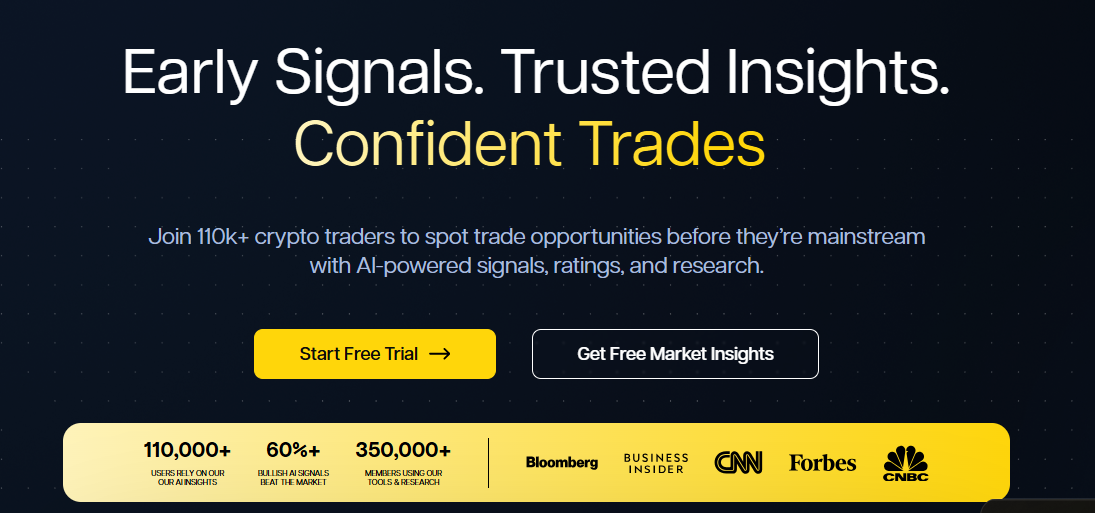
Token Metrics is not an exchange, but a crypto analytics and trading intelligence platform powered by AI. It offers:
Token Metrics bridges the gap between raw data and actionable decisions. Whether you’re a beginner or a pro running algorithmic strategies, Token Metrics delivers the AI layer needed to outperform the market.
Traders use Token Metrics alongside centralized exchanges (like Binance or Coinbase) or DEXs to validate trades, identify top-performing narratives, and automate entry/exit based on AI signals.
Binance is one of the world's largest cryptocurrency exchanges, allowing users to buy, sell, and trade hundreds of digital assets including Bitcoin, Ethereum, and other cryptocurrencies.
Founded in 2017 by Changpeng Zhao, the platform offers spot trading, futures, staking, and various other crypto-related financial services to millions of users globally.
Coinbase is ideal for retail investors and new traders. While it lacks advanced AI features, it’s a trusted fiat gateway.
Advanced users can subscribe to Coinbase Advanced or integrate with tools like Token Metrics to make smarter trading decisions.
Bybit offers both spot and derivatives, plus social trading tools like copy trading. It’s popular with swing and leverage traders.
Combine Bybit with Token Metrics for AI-driven entry points on high-volatility setups.
Kraken is known for strong security and a transparent track record. It supports spot, margin, and futures trading.
When paired with AI tools, Kraken becomes a secure execution venue for data-driven strategies.
OKX offers robust bot features, including grid trading and DCA bots. For users who prefer built-in automation, OKX is a solid option.
Still, Token Metrics outperforms on signal generation, narrative tracking, and AI-backed token scoring—making it an ideal data source for OKX bots.
As cryptocurrency trading evolves, manual strategies alone can’t keep up. Market cycles are faster, token launches are more frequent, and volatility is constant. This is where crypto AI trading shines.
Here’s why more traders are adopting AI:
Platforms like Token Metrics make this technology accessible—offering plug-and-play AI indices, custom signals, and portfolio intelligence for retail traders, funds, and institutions alike.
Cryptocurrency trading is becoming more competitive, data-driven, and automated. With the rise of crypto AI trading, traders now have the tools to gain a true edge—whether they’re investing $100 or managing $1M.
If you’re serious about crypto trading in 2025, don’t just guess—trade with data, trade with AI.
Explore how Token Metrics can power your portfolio with AI-generated insights, real-time signals, and next-generation trading tools.
.png)
%201.svg)
%201.svg)
The Token Metrics API has officially launched on Hacker News, marking a major milestone in our mission to bring AI-powered crypto insights to every developer, founder, and builder in the Web3 space.
If you're building trading bots, dashboards, investment tools, or AI agents that interact with the crypto market, this is your developer edge in 2025. Forget raw feeds and static charts—this is real-time, AI-grade crypto intelligence available in minutes via a single API key.
The Token Metrics API is a powerful crypto intelligence engine built for developers who want more than just price data. It combines machine learning, quantitative modeling, and narrative indexing to deliver structured signals that help users make smarter trading decisions.
Instead of simply showing what the market did, the API helps predict what it might do—with insights like:
It’s like giving your crypto bot a brain—and not just any brain, an AI-trained crypto analyst that never sleeps.
Most APIs give you prices, volume, and maybe some on-chain data. Token Metrics gives you opinionated intelligence derived from over 80 on-chain, off-chain, technical, and sentiment indicators.
That means:
We’ve designed this API for modularity and plug-and-play usability. With 21+ endpoints and official SDKs, you can ship faster and smarter—no custom pipeline needed.
Whether you're a solo developer or building inside a Web3 team, the possibilities are wide open.
Build smarter with Token Metrics if you’re creating:
Because the API supports OpenAI, Claude, Cursor, and Raycast integrations, your agents and LLM-powered tools can query live crypto intelligence in natural language—no additional parsing required.
Token Metrics API just made it to the front page of Hacker News, one of the internet’s most trusted platforms for discovering high-impact developer tools.
This means:
If you’ve been waiting for the right time to integrate AI-native crypto signals into your product—this is it.
We’re offering 5,000 free API calls/month for every new developer.
Sign up, plug in your key, and build:
Your users don’t just want raw data anymore—they want insights. Token Metrics delivers those insights in real time, with zero guesswork.
💥 Explore the API – Get your key in 30 seconds
💬 Join the Hacker News discussion – See what other devs are saying
📚 Browse Docs – View full endpoints and SDKs
One API. One schema. Smarter crypto apps.
The future of crypto building is AI-powered—and it starts here.

%201.svg)
%201.svg)
Crypto moves fast — and traders who can't read the signs get left behind. But in a market where emotions dominate, how do you distinguish between a real trend and a fakeout? That’s where AI-powered trading signals come in.
Token Metrics AI monitors over 6,000 tokens using 80+ data points, from technical momentum to on-chain activity and social sentiment. Its bullish and bearish signals aren’t just flashes of color — they’re actionable, data-driven insights that can guide decisions in chaotic markets.
In this post, we break down how to interpret bullish and bearish signals, what they’ve been saying recently, and how to react when market direction flips suddenly.
What Are Bullish and Bearish Signals?
Let’s start with the basics:
But these signals aren’t standalone — they come with contextual grades, like the Trader Grade, which ranks signal strength from 0 to 100. This allows you to not just know the direction, but the confidence behind it.
What Happened Recently? The May 30 Flip
On May 30, 2025, Token Metrics AI issued a broad bearish flip across much of the market. That included:
The AI signal flipped red, and Trader Grades fell across the board. Why? Here's what the AI detected:
This wasn’t panic-driven — it was a data-driven, proactive warning that the cycle had peaked. In a world where most traders rely on lagging indicators or Twitter sentiment, this was an edge.
How to Interpret a Bullish Signal
A bullish signal isn’t an instant “buy” — it's a call to investigate. Here's what to check when a green dot appears:
This means high conviction. If it's between 60–79, the trend is forming, but may lack strength.
Price up + volume up = good. Price up + volume flat = caution.
If the token fits a hot theme (like RWAs or AI), that adds strength to the signal.
Did the signal appear after a breakout, or just before? Entry timing depends on whether you're catching the beginning or chasing the middle of the trend.
If 3–5 similar tokens are also turning bullish, that indicates sector-wide rotation — a better entry environment.
How to Interpret a Bearish Signal
Red doesn’t mean "dump immediately" — it means it's time to tighten your risk.
This indicates deteriorating conviction — exit or reduce exposure.
If price is flat but volume is fading, that’s a warning of a potential breakdown.
Did the bearish flip happen near local highs? That’s often the best exit point.
Was this the second red dot in a week? That could confirm a longer-term downtrend.
If Bitcoin or ETH also flip bearish, it may suggest macro pressure, not just token-specific weakness.
Real-Time Examples from the Webinar
During the June 5 Token Metrics webinar, we walked through examples of how these signals worked in real time:
Strong signal, grade in the 80s. Resulted in a massive short-term run.
Signal turned red around $3,490. Traders who followed it avoided the 55% drawdown that followed.
After a 700% run-up, the signal flipped bearish with a low Trader Grade of ~24. Result? A slow bleed lower as sentiment cooled.
What Makes AI Signals Different from Traditional TA?
Feature Token Metrics AI Traditional TA
Combines social + on-chain ✅ ❌
Updated in real time ✅ ❌
Machine learning trained on past data ✅ ❌
Outputs confidence grade ✅ ❌
Adapts to new narratives ✅ ❌
This isn’t about moving averages or MACD — it’s about combining the entire digital footprint of a token to anticipate what comes next.
How to React to a Signal Flip
What do you do when your favorite token suddenly flips from bullish to bearish?
Your job isn’t to predict the market. It’s to respond to what the data is saying.
How to Combine AI Signals with a Strategy
Here’s a basic framework:
This keeps your system simple, repeatable, and data-driven.
Conclusion
In volatile markets, conviction matters. Token Metrics AI doesn’t just point up or down — it tells you how strong the trend is, how likely it is to last, and when it’s time to pivot.
Don’t trade on emotions. Don’t chase hype. Use the signals — and trust the grade.
Because in a market that never sleeps, it pays to have an AI watching your back.

%201.svg)
%201.svg)
The euphoria of April and May in the crypto market has officially hit the brakes. While traders were riding high just weeks ago, the mood has shifted — and the data confirms it. Token Metrics’ proprietary AI signals flipped bearish on May 30, and since then, the market has been slowly but steadily declining.
In this post, we break down what’s happened since the bearish signal, how major altcoins and sectors are reacting, and what Token Metrics’ indicators are telling us about what might come next.
The Big Picture: Cooling Off After a Hot Q1 and Q2 Start
The platform’s AI signal turned bearish on May 30 when the total crypto market cap hit $3.34 trillion. Since then, the momentum that defined early 2025 has reversed.
This wasn’t a sudden crash — it’s a slow bleed. The signal shift didn’t come from headline-driven panic, but from data-level exhaustion: volume softening, sentiment stalling, and trend strength fading across most tokens.
Token Metrics AI recognized the shift — and issued the warning.
What the Bearish Signal Means
The AI model analyzes over 80 metrics across price, volume, sentiment, and on-chain data. When key trends across these data sets weaken, the system flips from bullish (green) to bearish (red).
On May 30:
According to the model, these were signs of a broad de-risking cycle — not just isolated weakness.
Sectors Showing Declines
Even tokens that had been performing well throughout Q2 began to stall or roll over.
Previously one of the top performers in April, Launch Coin saw its grades decrease and price action softened.It may even be rebranding — a typical signal that a project is pivoting after a hype cycle.
RWAs were hot in March–May, but by early June, volume and signal quality had cooled off significantly.
Projects like Starknet and zkSync, once dominant in trader attention, have seen signal strength drop, with many now scoring below 70.
The cooling effect is broad, touching narratives, sectors, and high-performing individual tokens alike.
The Bull-Bear Indicator in Action
One of the key tools used by Token Metrics is the Bull vs. Bear Indicator, which aggregates bullish vs. bearish signals across all tokens tracked.
As of early June:
This isn’t fear — it’s fatigue.
How Traders Are Reacting
During the webinar, we noted that many users who rely on Token Metrics signals began rotating into stables once the May 30 signal flipped. Others reduced leverage, paused entries, or shifted into defensive plays like ETH and BTC.
This reflects an important philosophy:
"When the data changes, we change our approach."
Instead of trying to fight the tape or chase rebounds, disciplined traders are using the bearish signal to protect gains and preserve capital.
What About Ethereum and Bitcoin?
Even ETH and BTC, the two bellwether assets, aren’t immune.
In previous cycles, ETH and BTC acted as shelters during altcoin corrections. But now, even the majors show weakness — another reason why the bearish flip matters.
What Could Reverse This?
Abdullah Sarwar, head of research at Token Metrics, mentioned that for the signals to flip back bullish, we would need to see:
Until then, the system will remain in defensive mode — prioritizing safety over chasing trades.
How to Act During a Bearish Signal
The team offered several tips for traders during this cooling-off period:
These tools help find exceptions in a weak market.
Conclusion: Bearish Doesn’t Mean Broken
Markets cycle — and AI sees it before headlines do.
Token Metrics' bearish signal wasn’t a call to panic. It was a calibrated, data-backed alert that the trend had shifted — and that it was time to switch from offense to defense.
If you’re navigating this new phase, listen to the data. Use the tools. And most importantly, avoid trading emotionally.
The bull market might return. When it does, Token Metrics AI will flip bullish again — and you’ll be ready.

%201.svg)
%201.svg)
To test the accuracy of Token Metrics' proprietary AI signals, we conducted a detailed six-month backtest across three different tokens — Fartcoin, Bittensor ($TAO), and Ethereum. Each represents a unique narrative: memecoins, AI infrastructure, and blue-chip Layer 1s. Our goal? To evaluate how well the AI’s bullish and bearish signals timed market trends and price action.
The green and red dots on the following Fartcoin price chart represent the bullish and bearish market signals, respectively. Since Nov 26, 2024, Token Metrics AI has given 4 trading signals for Fartcoin. Let’s analyze each signal separately.

The Fartcoin chart above displays green and red dots that mark bullish and bearish signals from the Token Metrics AI, respectively. Over the last six months — starting November 26, 2024 — our system produced four significant trade signals for Fartcoin. Let’s evaluate them one by one.
The first major signal was bullish on November 26, 2024, when Fartcoin was trading at $0.29. This signal preceded a massive run-up, with the price topping out at $2.49. That’s an astounding 758% gain — all captured within just under two months. It’s one of the most powerful validations of the AI model’s ability to anticipate momentum early.
Following that rally, a bearish signal was triggered on January 26, 2025, just before the market corrected. Fartcoin retraced sharply, plunging 74.76% from the highs. Traders who acted on this bearish alert could have avoided substantial drawdowns — or even profited through short-side exposure.
On March 25, 2025, the AI turned bullish again, as Fartcoin traded near $0.53. Over the next several weeks, the token surged to $1.58, a 198% rally. Again, the AI proved its ability to detect upward momentum early.
Most recently, on June 1, 2025, Token Metrics AI flipped bearish once again. The current Trader Grade of 24.34 reinforces this view. For now, the system warns of weakness in the memecoin market — a trend that appears to be playing out in real-time.
Across all four trades, the AI captured both the explosive upside and protected traders from steep corrections — a rare feat in the volatile world of meme tokens.

Next, we examine Bittensor, the native asset of the decentralized AI Layer 1 network. Over the last six months, Token Metrics AI produced five key signals — and the results were a mixed bag but still largely insightful.
In December 2024, the AI turned bearish around $510, which preceded a sharp decline to $314 by February — a 38.4% drawdown. This alert helped traders sidestep a brutal correction during a high-volatility period.
On February 21, 2025, the system flipped bullish, but this trade didn't play out as expected. The price dropped 25.4% after the signal. Interestingly, the AI reversed again with a bearish signal just five days later, showing how fast sentiment and momentum can shift in emerging narratives like AI tokens.
The third signal marked a solid win: Bittensor dropped from $327 to $182.9 following the bearish call — another 44% drop captured in advance.
In April 2025, momentum returned. The AI issued a bullish alert on April 19, with TAO at $281. By the end of May, the token had rallied to over $474, resulting in a 68.6% gain — one of the best performing bullish signals in the dataset.
On June 4, the latest red dot (bearish) appeared. The model anticipates another downward move — time will tell if it materializes, but the track record suggests caution is warranted.

Finally, we analyze the AI’s predictive power for Ethereum, the second-largest crypto by market cap. Over the six-month window, Token Metrics AI made three major calls — and each one captured critical pivots in ETH’s price.
On November 7, 2024, a green dot (bullish) appeared when ETH was priced at $2,880. The price then surged to $4,030 in less than 40 days, marking a 40% gain. For ETH, such a move is substantial and was well-timed.
By December 24, the AI flipped bearish with ETH trading at $3,490. This signal was perhaps the most important, as it came ahead of a major downturn. ETH eventually bottomed out near $1,540 in April 2025, avoiding a 55.8% drawdown for those who acted on the signal.
In May 2025, the AI signaled another bullish trend with ETH around $1,850. Since then, the asset rallied to $2,800, creating a 51% gain.
These three trades — two bullish and one bearish — show the AI’s potential in navigating large-cap assets during both hype cycles and corrections.Backtesting Token Metrics AI across memecoins, AI narratives, and Ethereum shows consistent results: early identification of breakouts, timely exit signals, and minimized risk exposure. While no model is perfect, the six-month history reveals a tool capable of delivering real value — especially when used alongside sound risk management.
Whether you’re a trader looking to time the next big altcoin rally or an investor managing downside in turbulent markets, Token Metrics AI signals — available via the fastest crypto API — offer a powerful edge.

Backtesting Token Metrics AI across memecoins, AI narratives, and Ethereum shows consistent results: early identification of breakouts, timely exit signals, and minimized risk exposure. While no model is perfect, the six-month history reveals a tool capable of delivering real value — especially when used alongside sound risk management.
Whether you’re a trader looking to time the next big altcoin rally or an investor managing downside in turbulent markets, Token Metrics AI signals — available via the fastest crypto API — offer a powerful edge.

%201.svg)
%201.svg)
As the crypto ecosystem rapidly matures, developers, quant traders, and crypto-native startups are relying more than ever on high-quality APIs to build data-powered applications. Whether you're crafting a trading bot, developing a crypto research platform, or launching a GPT agent for market analysis, choosing the right API is critical.
Two names dominate the space in 2025: CoinGecko and Token Metrics. But while both offer access to market data, they serve fundamentally different purposes. CoinGecko is a trusted source for market-wide token listings and exchange metadata. Token Metrics, on the other hand, delivers AI-powered intelligence for predictive analytics and decision-making.
Let’s break down how they compare—and why the Token Metrics API is the superior choice for advanced, insight-driven builders.
At the core of Token Metrics is machine learning and natural language processing. It’s not just a data feed. It’s an AI that interprets the market.
In contrast, CoinGecko is primarily a token and exchange aggregator. It offers static data: price, volume, market cap, supply, etc. It’s incredibly useful for basic info—but it lacks context or predictive modeling.
✅ Winner: Token Metrics — The only crypto API built for AI-native applications and intelligent automation.
While CoinGecko covers more tokens and more exchanges, Token Metrics focuses on providing actionable insights rather than exhaustively listing everything.
Feature Token Metrics API CoinGecko API
Real-time + historical OHLCV ✅ ✅
Trader/Investor Grades ✅ AI-powered ❌
Exchange Aggregation ✅ (Used in indices, not exposed) ✅
Sentiment & Social Scoring ✅ NLP-driven ❌
AI Signals ✅ ❌
Token Fundamentals ✅ Summary via deepdive ⚠️ Limited
endpoint
NFT Market Data ❌ ✅
On-Chain Behavior ✅ Signals + Indices ⚠️ Pro-only (limited)
If you're building something analytics-heavy—especially trading or AI-driven—Token Metrics gives you depth, not just breadth.
✅ Verdict: CoinGecko wins on broad metadata coverage. Token Metrics wins on intelligence and strategic utility.
One of the biggest barriers in Web3 is getting devs from “idea” to “prototype” without friction. Token Metrics makes that easy.
✅ Winner: Token Metrics — Serious devs save hours with ready-to-go SDKs and utilities.
While CoinGecko’s no-login access is beginner-friendly, Token Metrics offers far more power per call. With just a few queries, your app can determine which tokens are gaining momentum, which are losing steam, and how portfolios should be adjusted.
✅ Winner: Token Metrics — Better for sustained usage, scaling, and production reliability.
Plan Feature CoinGecko Pro Token Metrics API
Entry Price ~$150/month $99/month
AI Grades & Signals ❌ ✅
Sentiment Analytics ❌ ✅
Sector Index Insights ❌ ✅
NLP Token Summaries ❌ ✅
Developer SDKs ❌ ✅
Token-Based Discounts ❌ ✅ (up to 35% with $TMAI)
For what you pay, Token Metrics delivers quant models and intelligent signal streams — not just raw price.
✅ Winner: Token Metrics — Cheaper entry, deeper value.
If you're building a crypto price tracker, NFT aggregator, or exchange overview site, CoinGecko is a solid foundation. It’s reliable, broad, and easy to get started.
But if your product needs to think, adapt, or help users make better decisions, then Token Metrics API is in another class entirely.
You're not just accessing data — you're integrating AI, machine learning, and predictive analytics into your app. That’s the difference between showing the market and understanding it.
.png)
%201.svg)
%201.svg)
If you’re a Python developer looking to build smarter crypto apps, bots, or dashboards, you need two things: reliable data and AI-powered insights. The Token Metrics API gives you both. In this tutorial, we’ll show you how to quickly get started using Token Metrics as your Python crypto price API, including how to authenticate, install the SDK, and run your first request in minutes.
Whether you’re pulling live market data, integrating Trader Grades into your trading strategy, or backtesting with OHLCV data, this guide has you covered.
Install the official Token Metrics Python SDK:
pip install tokenmetrics
Or if you prefer working with requests directly, no problem. We’ll show both methods below.
Before anything else, you’ll need a Token Metrics account.
You can monitor usage, rate limits, and quotas right from the dashboard. Track each key’s status, last used date, and revoke access at any time.
Here’s a simple example to fetch the latest price data for Ethereum (ETH):
import requests
API_KEY = "YOUR_API_KEY"
headers = {"x-api-key": API_KEY}
url = "https://api.tokenmetrics.com/v2/daily-ohlcv?symbol=ETH&startDate=<YYYY-MM-DD>&endDate=<YYYY-MM-DD>"
response = requests.get(url, headers=headers)
data = response.json()
for candle in data['data']:
print(f"Date: {candle['DATE']} | Close: ${candle['CLOSE']}")
You now have a working python crypto price API pipeline. Customize startDate or endDate to get specific range of historical data.
Token Metrics’ secret sauce is its AI-driven token ratings. Here’s how to access Trader Grades for ETH:
grade_url = "https://api.tokenmetrics.com/v2/trader-grades?symbol=ETH&limit=30d"
grades = requests.get(grade_url, headers=headers).json()['data']
for day in grades:
print(f"{day['DATE']} — Trader Grade: {day['TA_GRADE']}")
Use this data to automate trading logic (e.g., enter trades when Grade > 85) or overlay on charts.
Want to test a strategy? Merge OHLCV and Trader Grades for any token:
import pandas as pd
ohlcv_df = pd.DataFrame(data['data'])
grades_df = pd.DataFrame(grades)
combined_df = pd.merge(ohlcv_df, grades_df, on="DATE")
print(combined_df.head())
Now you can run simulations, build analytics dashboards, or train your own models.
All endpoints return structured JSON and can be queried via requests, axios, or any modern client.
You can reduce your API bill by up to 35% by staking and paying with Token Metrics’ native token, $TMAI. Available via the settings → payments page.
🌐 Final Thoughts
If you're searching for the best python crypto price API with more than just price data, Token Metrics is the ultimate choice. It combines market data with proprietary AI intelligence, trader/investor grades, sentiment scores, and backtest-ready endpoints—all in one platform.
✅ Real-time & historical data
✅ RESTful endpoints
✅ Python-ready SDKs and docs
✅ Free plan to start building today
Start building today → tokenmetrics.com/api
Looking for SDK docs? Explore the full Python Quick Start Guide

%201.svg)
%201.svg)
If you're a trader, data analyst, or crypto enthusiast, chances are you've wanted to pull live crypto data directly into Google Sheets. Whether you're tracking prices, building custom dashboards, or backtesting strategies, having real-time data at your fingertips can give you an edge.
In this guide, we'll show you how to integrate the Token Metrics API — a powerful crypto API with free access to AI-powered signals — directly into Google Sheets in under 5 minutes using Google Apps Script.
Google Sheets is a flexible, cloud-based spreadsheet that:
When combined with the Token Metrics API, it becomes a powerful dashboard that updates live with Trader Grades, Bull/Bear Signals, historical OHLCV data, and more.
The Token Metrics API provides real-time and historical crypto data powered by AI. It includes:
The best part? The free Basic Plan includes:
Here’s how to get live AI-powered crypto data into Sheets using Google Apps Script.
const TOKEN_METRICS_API_KEY = 'YOUR_API_KEY_HERE';
async function getTraderGrade(symbol) {
const url = `https://api.tokenmetrics.com/v2/trader-grades?symbol=${symbol.toUpperCase()}`;
const options = {
method: 'GET',
contentType: 'application/json',
headers: {
'accept': 'application/json',
'x-api-key': TOKEN_METRICS_API_KEY,
},
muteHttpExceptions: true
};
const response = UrlFetchApp.fetch(url, options);
const data = JSON.parse(response.getContentText() || "{}")
if (data.success && data.data.length) {
const coin = data.data[0];
return [
coin.TOKEN_NAME,
coin.TOKEN_SYMBOL,
coin.TA_GRADE,
coin.DATE
];
} else {
return ['No data', '-', '-', '-'];
}
}
async function getSheetData() {
const sheet = SpreadsheetApp.getActiveSpreadsheet().getActiveSheet();
const symbols = sheet.getRange('A2:A').getValues().flat().filter(Boolean);
const results = [];
results.push(['Name', 'Symbol', 'Trader Grade', 'Date']);
for (const symbol of symbols) {
if (symbol) {
const row = await getTraderGrade(symbol);
results.push(row);
}
}
sheet.getRange(2, 2, results.length, results[0].length).setValues(results);
}
Note: The first time, Google will ask for permission to access the script.
After the script runs, you’ll see:
You can now:
Unlike basic price APIs, Token Metrics offers AI-driven metrics that help you:
And all of this starts for free.
Here’s what else you can build:
You can also upgrade to the Advanced Plan to unlock 21 endpoints including:
Never share your API key in a public Google Sheet. Use script-level access and keep the sheet private unless required.
{
"@context": "https://schema.org",
"@type": "HowTo",
"name": "Crypto API to Google Sheets in 5 Minutes",
"description": "Learn how to connect the Token Metrics crypto API to Google Sheets using Google Apps Script and get real-time AI-powered signals and prices.",
"totalTime": "PT5M",
"supply": [
{
"@type": "HowToSupply",
"name": "Google Sheets"
},
{
"@type": "HowToSupply",
"name": "Token Metrics API Key"
}
],
"tool": [
{
"@type": "HowToTool",
"name": "Google Apps Script"
}
],
"step": [
{
"@type": "HowToStep",
"name": "Get Your API Key",
"text": "Sign up at Token Metrics and generate your API key from the API dashboard."
},
{
"@type": "HowToStep",
"name": "Create a New Google Sheet",
"text": "Open a new sheet and list crypto symbols in column A."
},
{
"@type": "HowToStep",
"name": "Add Apps Script",
"text": "Go to Extensions > Apps Script and paste the provided code, replacing your API key."
},
{
"@type": "HowToStep",
"name": "Run the Script",
"text": "Execute the getSheetData function to pull data into the sheet."
}
]
}
If you're serious about crypto trading or app development, integrating live market signals into your workflow can be a game-changer. With the Token Metrics API, you can get institutional-grade AI signals — right inside Google Sheets.
This setup is simple, fast, and completely free to start. Try it today and unlock a smarter way to trade and build in crypto.
.png)
%201.svg)
%201.svg)
Liquidity farming just got a major upgrade. Token Metrics AI ($TMAI) has launched its first liquidity incentive campaign on Merk — and it’s designed for yield hunters looking to earn fast, with no lockups, no gimmicks, and real rewards from Day 1.
For two weeks, liquidity providers can earn high daily rewards across three different pools. All rewards are paid in $TMAI and distributed continuously — block by block — through the Merkl platform.
Pool Starting APR % Total Rewards (14 days) Current TVL
Aerodrome WETH–TMAI 150% 16.79M TMAI (~$11,000) $86,400
Uniswap v3 USDC–TMAI 200% 14.92M TMAI (~$9,800) $19,900
Balancer 95/5 WETH–TMAI 200% 5.60M TMAI (~$3,700) $9,500
These pools are live and actively paying rewards. APR rates aren’t displayed on Merkl until the first 24 hours of data are available — but early providers will already be earning.
1. Turbo Rewards for a Short Time
This isn’t a slow-drip farm. The TMAI Merkl campaign is designed to reward action-takers. For the first few days, yields are especially high — thanks to low TVL and full daily reward distribution.
2. No Lockups or Waiting Periods
You can provide liquidity and withdraw it anytime — even the same day. There are no lockups, no vesting, and no delayed payout mechanics. All rewards accrue automatically and are claimable through Merkl.
3. Choose Your Risk Profile
You get to pick your exposure.
4. Influence the Future of TMAI Yield Farming
This campaign isn’t just about yield — it’s a test. If enough users participate and volume grows, the Token Metrics Treasury will consider extending liquidity rewards into Q3 and beyond. That means more TMAI emissions, longer timelines, and consistent passive income opportunities for LPs.
5. Built for Transparency and Speed
Rewards are distributed via Merkl by Angle Labs, a transparent, gas-efficient platform for programmable liquidity mining. You can see the exact rewards, TVL, wallet counts, and pool analytics at any time.
Getting started is simple. You only need a crypto wallet, some $TMAI, and a matching asset (either WETH or USDC, depending on the pool).
Step-by-step:
This is a rare opportunity to earn serious rewards in a short amount of time. Whether you’re new to liquidity mining or a DeFi veteran, the TMAI Merkl campaign is built for speed, flexibility, and transparency.
You’re still early. The best yields happen in the first days, before TVL rises and APR stabilizes. Dive in now and maximize your returns while the turbo phase is still on.
👉 Join the Pools and Start Earning


 Create Your Free Account
Create Your Free Account9450 SW Gemini Dr
PMB 59348
Beaverton, Oregon 97008-7105 US
.svg)




.png)
Token Metrics Media LLC is a regular publication of information, analysis, and commentary focused especially on blockchain technology and business, cryptocurrency, blockchain-based tokens, market trends, and trading strategies.
Token Metrics Media LLC does not provide individually tailored investment advice and does not take a subscriber’s or anyone’s personal circumstances into consideration when discussing investments; nor is Token Metrics Advisers LLC registered as an investment adviser or broker-dealer in any jurisdiction.
Information contained herein is not an offer or solicitation to buy, hold, or sell any security. The Token Metrics team has advised and invested in many blockchain companies. A complete list of their advisory roles and current holdings can be viewed here: https://tokenmetrics.com/disclosures.html/
Token Metrics Media LLC relies on information from various sources believed to be reliable, including clients and third parties, but cannot guarantee the accuracy and completeness of that information. Additionally, Token Metrics Media LLC does not provide tax advice, and investors are encouraged to consult with their personal tax advisors.
All investing involves risk, including the possible loss of money you invest, and past performance does not guarantee future performance. Ratings and price predictions are provided for informational and illustrative purposes, and may not reflect actual future performance.

